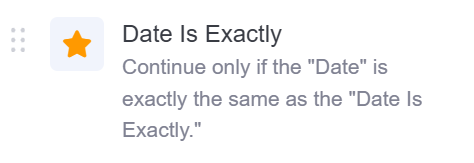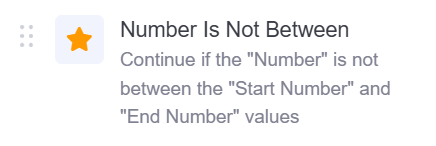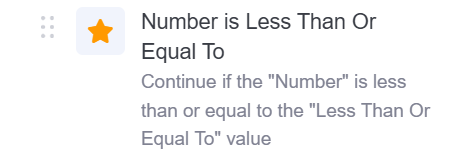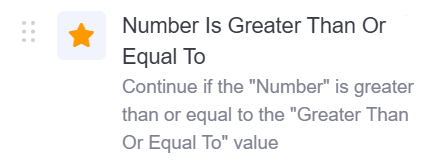Last updated: 03 October 2025
Help Documentation
Main Operator Documentation
Conditional Operators
Conditional Operators are "gates" that allow or prevent the logic flow to continue through the current branch. If a conditional returns 'true' for a path, the logic for that branch continues. If the conditional is 'false', then the logic for that branch is stopped. If the condition is true, in the History Tab on testing, the status will read Success, else it will be Success - Condition(s) Not Passed. The Reason for success or failure is provided under Explanation.
Data Types Evaluated by Conditional Operators
Conditional Operators compare the following based on predefined logical and mathematical criteria:
Date
Conditional Operators allow logical evaluations based on date values, making them useful for automation and validation.
Comparisons on date made by Conditional Operators:
Date Is Exactly
Checks if the two dates are exactly the same.

Input Fields:
- Default Configuration: This picklist field enables to choose a default configuration. This will automatically populate all fields for that operator with default configuration values wherever available.
- Date: The Date to compare.
- Date Is Exactly: The date to compare "Date" to. If the "Date" is equal to the "Date is Exactly", it returns true and proceeds.
Date Is Before
Checks if the "Date" is strictly before the "Date Is Before".

Input Fields:
- Default Configuration: This picklist field enables to choose a default configuration. This will automatically populate all fields for that operator with default configuration values wherever available.
- Date: The Date to compare.
- Date Is Before: The date to compare "Date" to. If the "Date" is before the "Date Is Before", it returns true and proceeds.
Date Is After
Checks if the "Date" is strictly after the "Date Is After".

Input Fields:
- Default Configuration: This picklist field enables to choose a default configuration. This will automatically populate all fields for that operator with default configuration values wherever available.
- Date: The Date to compare.
- Date Is After: The date to compare "Date" to. If the "Date" is after the "Date Is After", it returns true and proceeds.
Date Is Between
Checks if the "Date" provided is between the "Start Date" and "End Date".

Input Fields:
- Default Configuration: This picklist field enables to choose a default configuration. This will automatically populate all fields for that operator with default configuration values wherever available.
- Date: The Date to find out whether it is between the range.
- Start Date: The start date of the range.
- End Date: The end date of the range. If the "Date" is between the "Start Date" and "End Date", it returns true and proceeds.
Date Is Not Between
Checks if the "Date" provided is not between the "Start Date" and "End Date".

Input Fields:
- Default Configuration: This picklist field enables to choose a default configuration. This will automatically populate all fields for that operator with default configuration values wherever available.
- Date: The Date to find out whether it is not between the range.
- Start Date: The start date of the range.
- End Date: The end date of the range. If the "Date" is not between the "Start Date" and "End Date", it returns true and proceeds.
Number
Conditional Operators allow logical evaluations based on Numbers, making them useful for automation and validation.
Comparisons on numbers made by Conditional Operators:
Number Is Equal To
Checks if the "Number" is equal to "Equal To" value.

Input Fields:
- Default Configuration: This picklist field enables to choose a default configuration. This will automatically populate all fields for that operator with default configuration values wherever available.
- Number: The number to compare.
- Equal To: The number to compare "Number" to. If the "Number" is equal to the "Equal To", it returns true and proceeds.
Number Is Not Equal To
Checks if the "Number" is not equal to "Not Equal To" value.

Input Fields:
- Default Configuration: This picklist field enables to choose a default configuration. This will automatically populate all fields for that operator with default configuration values wherever available.
- Number: The number to compare.
- Not Equal To: The number to compare "Number" to. If the "Number" is not equal to "Not Equal To", it returns true and proceeds.
Number Is Between
Checks if the "Number" is between "Start Number" and "End Number" values.

Input Fields:
- Default Configuration: This picklist field enables to choose a default configuration. This will automatically populate all fields for that operator with default configuration values wherever available.
- Number: The Number to find out whether it is between the range.
- Start Number: The starting number of the range.
- End Number: The end number of the range. If the "Number" is between the "Start Number" and "End Number", it returns true and proceeds.
Number Is Not Between
Checks if the "Number" is not between the "Start Number" and "End Number" values.

Input Fields:
- Default Configuration: This picklist field enables to choose a default configuration. This will automatically populate all fields for that operator with default configuration values wherever available.
- Number: The Number to find out whether it is not between the range.
- Start Number: The starting number of the range.
- End Number: The end number of the range. If the "Number" is not between the "Start Number" and "End Number", it returns true and proceeds.
Number Is Less Than Or Equal To
Checks if the "Number" is less than or equal to "Number is Less Than or Equal To" value.

Input Fields:
- Default Configuration: This picklist field enables to choose a default configuration. This will automatically populate all fields for that operator with default configuration values wherever available.
- Number: The number to compare.
- Less Than or Equal To: The number to compare "Number" to. If the "Number" is less than or equal to "Less Than or Equal To", it returns true and proceeds.
Number Is Less Than
Checks if "Number" is less than "Less Than" value.

Input Fields:
- Default Configuration: This picklist field enables to choose a default configuration. This will automatically populate all fields for that operator with default configuration values wherever available.
- Number: The number to compare.
- Less Than: The number to compare "Number" to. If the "Number" is less than the "Less Than", it returns true and proceeds.
Number Is Greater Than Or Equal To
Checks if "Number" is greater than or equal to "Greater Than or Equal To" value

Input Fields:
- Default Configuration: This picklist field enables to choose a default configuration. This will automatically populate all fields for that operator with default configuration values wherever available.
- Number: The number to compare.
- Greater Than or Equal To: The number to compare "Number" to. If the "Number" is greater than or equal to "Greater Than or Equal To", it returns true and proceeds.
Number Is Greater Than
Checks if the "Number" is greater than "Greater Than" value.

Input Fields:
- Default Configuration: This picklist field enables to choose a default configuration. This will automatically populate all fields for that operator with default configuration values wherever available.
- Number: The number to compare.
- Greater Than: The number to compare "Number" to. If the "Number" is greater than the "Greater Than", it returns true and proceeds.
Text
Conditional Operators allow logical evaluations based on Text, making them useful for automation and validation.
Comparisons on text made by Conditional Operators:
Text Contains
Checks if the "Text Contains" value can be found within the "Text" field.

Input Fields:
- Default Configuration: This picklist field enables to choose a default configuration. This will automatically populate all fields for that operator with default configuration values wherever available.
- Text: The text to search "Text Conatins" in.
- Text Contains: The text to search in "Text". If the "Text" contains "Text Contains", it returns true and proceeds.
Text Does Not Contain
Checks if the "Text Does Not Contain" value cannot be found within the "Text" field.

Input Fields:
- Default Configuration: This picklist field enables to choose a default configuration. This will automatically populate all fields for that operator with default configuration values wherever available.
- Text: The text to search "Text Does Not Conatins" in.
- Text Does Not Contain: The text to search in "Text". If the "Text" does not contains "Text Does Not Contain", it returns true and proceeds.
Text Starts With
Checks if "Text" starts with the "Starts With" value.

Input Fields:
- Default Configuration: This picklist field enables to choose a default configuration. This will automatically populate all fields for that operator with default configuration values wherever available.
- Text: The text to search "Text Does Not Conatins" in.
- Text Starts With: The text to search in "Text". If the "Text" starts with "Text Starts With", it returns true and proceeds.
Text Does Not Start With:
Checks if the "Text" does not start with the "Does Not Start With" value.

Input Fields:
- Default Configuration: This picklist field enables to choose a default configuration. This will automatically populate all fields for that operator with default configuration values wherever available.
- Text: The text to search "Does Not Start With" in.
- Does Not Starts With: The text to search in "Text". If the "Text" dosen't start with "Does Not Start With", it returns true and proceeds.
Text Ends With
Checks if "Text" ends with the "Ends With" value.

Input Fields:
- Default Configuration: This picklist field enables to choose a default configuration. This will automatically populate all fields for that operator with default configuration values wherever available.
- Text: The text to search "Ends With" in.
- Ends With: The text to search in "Text". If the "Text" ends with "Ends With", it returns true and proceeds.
Text Does Not End With
Checks if the "Text" does not end with the "Text Does Not End With" value.

Input Fields:
- Default Configuration: This picklist field enables to choose a default configuration. This will automatically populate all fields for that operator with default configuration values wherever available.
- Text: The text to search "Does Not End With" in.
- Does Not End With: The text to search in "Text". If the "Text" dosen't end with "Does Not End With", it returns true and proceeds.
Text Is Exactly
Checks if the "Text" value exactly matches the "Text Is Exactly" value.

Input Fields:
- Default Configuration: This picklist field enables to choose a default configuration. This will automatically populate all fields for that operator with default configuration values wherever available.
- Text: The text to search "Text Is Exactly" in.
- Text Is Exactly: The text to search in "Text". If the "Text" is same as "Text Is Exactly", it returns true and proceeds.
Value
Conditional Operators allow logical evaluations based on whether there is a vaule in field or not, making them useful for automation and validation.
Comparisons on text made by Conditional Operators:
Value Is Empty
Checks if the "Value" field is empty.

Input Fields:
- Default Configuration: This picklist field enables to choose a default configuration. This will automatically populate all fields for that operator with default configuration values wherever available.
- Value: The field to check whether it is empty. If this field is empty, it returns true and proceeds.
Value Is Not Empty
Checks if the "Value" field is not empty.

Input Fields:
- Default Configuration: This picklist field enables to choose a default configuration. This will automatically populate all fields for that operator with default configuration values wherever available.
- Value: The field to check whether it is not empty. If this field is not empty, it returns true and proceeds.
Conditional Operator Examples
For examples of Conditional Operators: Conditional Operator Examples.